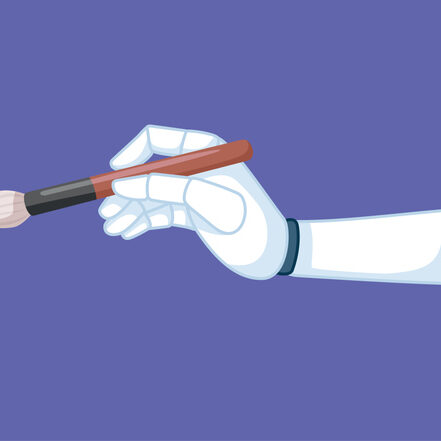Insights < BACK TO ALL INSIGHTS
District Court Rules that Robots Can’t Hold a Copyright
District Court Rules that Robots Can’t Hold a Copyright
By: Abbey Block
If asked to name the greatest artists of all time, you may think of well-known figures such as Vincent Van Gogh, Pablo Picasso, and Michelangelo. What do these artists have in common – apart from their creative talent? They’re human.
While that answer may seem painfully obvious, the humanity of authorship may not always be a foregone conclusion – particularly in a world where artificial intelligence (“AI”) can generate works of art that rival the sketches of history’s greatest creators.
Generative AI programs, such as DALL-E and Midjourney, allow users to input text prompts to generate one-of-a-kind images. The possibilities seem endless – users can generate hundreds of images of varying styles, mediums, and time periods. In its online user guide, Midjourney provides an example of the technology’s capabilities, demonstrating that a user may generate several versions of “cat illustration,” in varying styles, ranging from a charcoal sketch to an 1800’s-style formal portrait.
While this technology is undoubtedly both exciting and entertaining, it raises a question that has plagued artists for centuries – who is the rightful owner of the images being generated? And a more modern question – what kind of legal protections are afforded to artistic works created by AI?
The District Court of the District of Columbia recently weighed in on this issue in Thaler v. Perlmutter.[1] In that case, the Plaintiff utilized an AI computer system called the “Creativity Machine” to generate a piece of visual art entitled “A Recent Entrance to Paradise,” (the “Work”).[2] The Plaintiff sought to register the Work for a copyright and listed the Creativity Machine as its author on the application.[3] The Plaintiff sought to claim the copyright for himself as a “work-for-hire to the owner of the Creativity Machine.”[4] The Copyright Office denied the application “on the grounds that the work lacked human authorship, a prerequisite for a valid copyright to issue.”[5] The Plaintiff challenged the decision, arguing that the Copyright Office’s human authorship requirement should not apply and the AI should be acknowledged as the author of the work.[6]
The District Court disagreed, ruling unequivocally that “United States copyright law protects only works of human creation.”[7] In reaching this conclusion, the Court acknowledged that the protections provided by the copyright statute were intended to broadly encompass “‘any physical rendering of the fruits of creative[,] intellectual[,] or aesthetic labor.’”[8] Simply put, the statute was drafted and designed to adapt and evolve in light of changing technology and artistic mediums. However, the Court continued, underlying the statute’s intended adaptability is a “consistent understanding that human creativity is the sine qua non at the core of copyrightability, even as that human creativity is channeled through new tools or into new media.”[9] Given these principles, the Court concluded that no copyright had ever existed because the Work was generated without human involvement.[10]
In reaching this conclusion, the Court rejected several creative theories of ownership put forth by the Plaintiff.[11] For example, the Plaintiff argued that he was entitled to the copyright under the “work-for-hire provision” of the Copyright Act, given that he was the owner of the Machine that had produced the image.[12] That provision of the Act provides, in pertinent part, that “[i]n the case of work made for hire, the employer . . . owns all of the rights comprised in the copyright.”[13] The Court rejected this theory, concluding that because “the image autonomously generated by [P]laintiff’s computer system was never eligible for copyright,” a work-for-hire theory “put the cart before the horse.”[14] In other words, because there was no copyright in the first place, there were no rights for the Plaintiff to claim ownership over.[15] The Plaintiff’s ownership and control of the Creativity Machine was irrelevant.[16]
Although AI-generated art has recently grabbed the attention of legal and tech experts alike, this isn’t the first time the judicial system has had to tackle the issue of whether content created by a non-human can be afforded copyright protection. In 2018, the Ninth Circuit was asked to decide whether content, produced by a wild monkey, qualified for copyright protection.[17] The Ninth Circuit answered in the negative, concluding that animals could not sue for copyright infringement.[18] Similarly, in Urantia Foundation v. Maaherra, the Court declined to extend copyright protection to a book allegedly authored by “non-human spiritual beings,” explaining that “some element of human creativity must have occurred in order for the book to be copyrightable,” given that “it is not creations of divine beings that the copyright laws were intended to protect.”[19]
Even though these cases indicate that the case law is relatively settled for now, future technological developments may require courts and the legislature to adapt and stretch the boundaries of what is considered copyrightable. Indeed, in rendering its ruling in the Thaler case, the District Court acknowledged that future instances of AI-generated art may present a closer case for copyright protection. To that end, the Court opined,
Undoubtedly, we are approaching new frontiers in copyright as artists put AI in their toolbox to be used in the generation of new visual and other artistic works. The increased attenuation of human creativity from the actual generation of the final work will prompt challenging questions regarding how much human input is necessary to qualify the user of an AI system as an “author” of a generated work, the scope of the protection obtained over the resultant image, how to assess the originality of AI-generated works where the systems may have been trained on unknown pre-existing works, how copyright might best be used to incentivize creative works involving AI, and more.[20]
Given these sentiments, it is reasonable to conclude that the scope of copyright protection to be provided largely depends on the degree to which a human is involved in the creation of an AI-generated work. For example, if an author or artist uses the AI-generated image as a starting point for the creative work, the Copyright Office (and courts) may be more willing to extend legal protection. In other words, if a human tweaks, supplements, or arranges content created by AI, the work is more likely to be considered the product of human authorship. By contrast, if the human’s only involvement in the development of the work is the input of text prompts into an AI language-based model, copyright protection is not likely to be provided. The effort expended in working with the AI program – i.e., taking the time to brainstorm the perfect text prompt or researching a famous artist to incorporate into the machine’s input – remains largely irrelevant to the determination that content generated through AI is uncopyrightable.
This conclusion is supported by a recent decision of the U.S. Copyright Office, granting limited copyright protection to a comic book that included both (1) images generated by AI; and (2) text authored by a human creator. The Copyright Office explained that although the AI-generated images in the comic book were not copyrightable, the comic book’s “text” along with the “selection, coordination, and arrangement of text created by the author and artwork generated by artificial intelligence,” would be considered the product of human authorship.
The fact that the comic book’s author had “expended significant time and effort working with Midjourney,” did not change the result. The Copyright Office explained that it did not consider the amount of time, effort, or expense required to create the work given that those facts “have no bearing on whether a work possesses the minimum creative spark required by the Copyright Act and Constitution.” Simply put, the “sweat of the brow,” could not form the basis for copyright protection in “otherwise unprotectable material.”
Relying on the guidance of both the Courts and the Copyright Office, we can conclude that substantial human authorship remains the bedrock of copyright protection. Perhaps the law will evolve to provide some kind of legal protection – distinguishable from a traditional copyright – to images and other work generated by AI. Indeed, it seems likely that disputes over the ownership, authorship, and fair use of AI-generated work are on the horizon, creating a need for an evolution in the legislative framework normally relied on for legal challenges of that sort. Until then, aspiring AI artists should be advised that the work they create through AI technology may not be considered their own – at least in the legal, copyrightable sense.
[1] — F.Supp.3d —, Civil Action No. 22-1564 (BAH), 2023 WL 5333236, at *1 (D.D.C. Aug. 18, 2023).
[2] Id.
[3] Id.
[4] Id.
[5] Id.
[6] Id.
[7] Id. at *3 (emphasis added).
[8] Id. (quoting Goldstein v. California, 412 U.S. 546, 561 (1973)).
[9] Id.
[10] Id. at *6.
[11] See, e.g., id. (“Common law doctrines of property transfer cannot be implicated where no property right exists to transfer in the first instance.”).
[12] Id. at *1.
[13] Id. at *6 (quoting 17 U.S.C. § 201(b)).
[14] Id. at *3 (emphasis added).
[15] Id.
[16] Id. at *6.
[17] Naruto v. Slater, 888 F.3d 418, 420 (9th Cir. 2018).
[18] Id. at 426.
[19] 114 F.3d 955, 958 (9th Cir. 1997).
[20] Thaler, 2023 WL 5333236, at *6.





